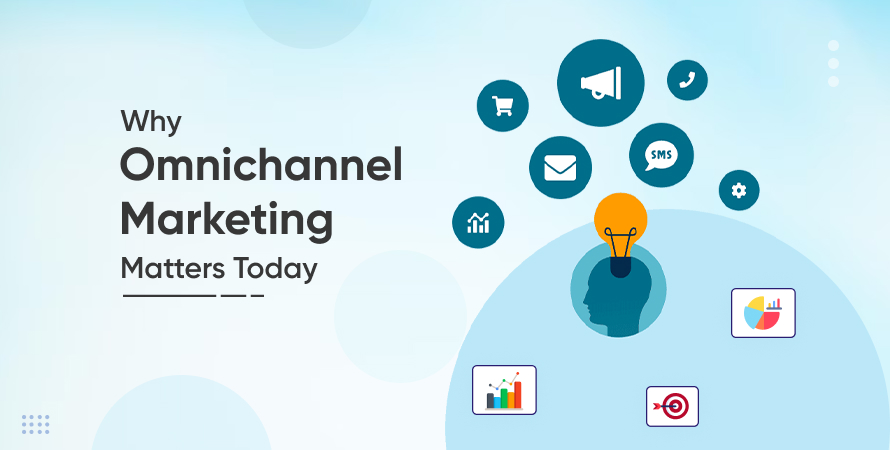Why Omnichannel Marketing Matters Today



Introduction
In today’s connected world, customers interact with brands in many ways—like through social media, websites, physical stores, and mobile apps. This shift has changed how businesses must reach and engage with their audience. Traditional marketing methods are no longer enough to meet the needs of modern consumers.
That’s where omnichannel marketing comes in. It’s a seamless marketing strategy that gives customers a consistent experience across all platforms and devices. For businesses that want to stay competitive and up to date, understanding the importance of omnichannel marketing is more important than ever.
This blog explains what omnichannel marketing is, how it’s different from multichannel marketing, the benefits it brings, the challenges you may face, and how a digital marketing agency can help build a strong omnichannel strategy. Whether you’re a marketer or a business owner, this guide will show you why investing in omnichannel marketing isn’t just a good idea—it’s essential for success today.
Omnichannel Marketing- Definition and Characteristics
To define, omnichannel marketing, it is about linking all your ways of communicating—online and offline—so customers have a smooth and steady experience. Unlike other methods that keep channels separate, omnichannel marketing makes sure your brand messages, customer details, and interactions are all connected and work as one.
Key characteristics include:
- Integration: All channels—like email, social media, physical stores, websites, mobile apps, and customer service—are connected and share information instantly.
- Consistency: Customers see the same message, tone, and offers whether they are using their phone, browsing your website, or shopping in a store.
- Personalization: Because all customer data is linked, brands can customize messages and offers based on what each customer likes and does.
For example, if someone adds a product to their cart online, they may later get a reminder email, see that product featured in the brand’s app, and even get a discount for it in-store—all working together to give them a smooth and connected shopping experience.
Omnichannel vs Multichannel Marketing: Key Differences
While people sometimes mix up the terms, omnichannel and multi-channel marketing are actually very different strategies.
- Multichannel marketing means reaching customers through different channels separately. For example, a brand might run one campaign on social media, another through email, and a different one in-store—but these efforts don’t connect with each other.
- Omnichannel marketing, however, links all these channels together so they work as one system.
| Aspect | Multichannel Marketing | Omnichannel Marketing |
|---|---|---|
| Channel Integration | Channels work separately | Channels are connected and work together |
| Customer Experience | Disconnected and inconsistent | Smooth and consistent across all platforms |
| Data Sharing | Little or no data sharing | Real-time data sharing across channels |
| Personalization | Basic or one-size-fits-all messages | Customized messaging using shared data |
| Customer Journey | Broken or separate touchpoints | Continuous and connected journey |
In today’s digital world, omnichannel marketing is preferred because it matches what customers expect—a smooth, connected experience no matter how or where they interact with a brand.
Why Omnichannel Marketing Matters Today
The importance of omnichannel marketing has grown dramatically in recent years due to several factors:
Changing Consumer Behavior:
Today’s customers move easily between different devices and platforms. Studies show they interact with brands in several ways before making a purchase. If the experience feels disconnected, it can lead to frustration and lost sales.
Rise of Mobile and Voice Commerce:
Many people now use their phones as their main way to shop, and voice assistants are becoming a new way to buy products. Omnichannel marketing helps include these tools in a smooth shopping experience.
Demand for Personalization:
Customers want brands to understand their needs and give them relevant suggestions. When data is collected from all channels and put together, it allows businesses to offer more personalized messages and offers.
Customer Retention and Loyalty:
When the shopping experience is smooth and enjoyable, customers are more likely to come back. Brands that use omni-channel strategies often see higher loyalty because customers feel recognized and appreciated.
Competitive Advantage:
Companies using an omnichannel marketing approach stand out by giving better customer experiences. This helps them build stronger brand trust and gain a bigger share of the market.
How a Seamless Marketing Approach Drives Conversions
A seamless marketing strategy connects all channels smoothly and makes the customer journey easier, which helps boost conversion rates.
Unified Customer Data:
When businesses collect data from every customer interaction, they get a clear picture of how people shop. This helps them send personalized messages and offers that are more likely to get results.
Shortened Decision Making:
When the same messages and product details appear across all platforms, customers don’t get confused. This helps them make buying decisions faster.
Reduced Cart Abandonment:
Omnichannel marketing often includes helpful reminders through email or mobile messages. These nudges encourage customers to finish purchases they started on another device or platform.
Consistent Brand Messaging:
When the brand message is the same everywhere, it builds trust. Customers feel more confident and are more likely to go ahead with a purchase.
Challenges of Omnichannel Marketing
Even though omni-channel marketing has many benefits, setting it up can be challenging:
Data Silos:
Bringing together customer data from different places—like websites, stores, CRMs, and social media—can be hard. Without the right tools, the data stays scattered, making it tough to personalize the customer experience.
Technology Overload:
Picking the right mix of platforms and tools to create a smooth system takes both time and expertise. It can be overwhelming without proper guidance.
Organizational Alignment:
To make omnichannel marketing work, teams from marketing, sales, customer service, and IT need to work closely together. This can be difficult when departments are used to working separately.
Resource Intensive:
Creating and running an omnichannel setup takes a lot of effort. It requires investment in tools, team training, and planning the right strategies.
A digital marketing agency can help solve these problems by offering expert guidance, strategic support, and the technical skills needed to bring teams and systems together successfully.
How to Build a Winning Omnichannel Strategy
Creating an omnichannel marketing approach requires careful planning and execution:
- Audit Existing Touchpoints: Find out where and how customers interact with your brand, both online and offline.
- Select Appropriate Platforms: Pick the channels that your target audience uses most and that fit your business goals.
- Map the Customer Journey: Learn the common paths customers take and spot key moments where channels should connect.
- Unify Data Sources: Use CRM and analytics tools to bring customer data together, allowing real-time updates and insights.
- Develop Consistent Messaging: Keep your tone, branding, and offers the same across all channels.
- Test and Optimize: Regularly check how your strategy is working and use customer feedback to make it better.
By following these steps, brands can create a smooth and engaging experience that helps their business grow.
The Role of a Digital Marketing Agency in Omnichannel Success
Executing an omnichannel marketing strategy is complex, which is why many businesses partner with a digital marketing agency. Agencies bring:
- Expertise in Technology: Guidance on selecting and integrating CRM, marketing automation, and analytics tools.
- Strategic Alignment: Experience in developing unified marketing plans tailored to specific industries and goals.
- Resource Efficiency: Access to specialized teams that handle data analysis, content creation, and campaign management.
- Continuous Improvement: Agencies monitor performance and adjust strategies based on evolving trends and customer behavior.
By leveraging an agency’s expertise, brands can navigate challenges, accelerate implementation, and maximize return on investment.
Conclusion
In today’s fast-moving and connected world, omnichannel marketing isn’t just a trend — it’s a must-have strategy for growing your business. Giving customers a smooth and personalized experience across all channels helps build loyalty, boost sales, and make your brand stand out.
If your business wants to build a connected marketing strategy but doesn’t know where to begin, working with a skilled team can make things easier. For expert help in creating a seamless marketing plan that strengthens your brand, consider teaming up with SEO Expert New York — your trusted digital marketing agency for success in omnichannel marketing.
Frequently Asked Questions (FAQs)
The main goal of omnichannel marketing is to give customers a smooth and connected experience across all platforms and touchpoints. It ensures they get consistent messages and personalized service, which helps build loyalty and satisfaction.
By linking all communication channels and sharing data, omnichannel marketing makes sure customers get the right content wherever they interact with your brand. This avoids confusion and creates a more enjoyable experience.
Yes. Even though it can take time and resources, small businesses can start by connecting their most important channels first. Using simple CRM tools and working with a digital marketing agency can help manage the process more easily.
You can measure success by looking at things like customer retention, sales conversion rates, average order value, and satisfaction scores. Tools that track behavior across all social media platforms help show how well your strategy is working.
No. While eCommerce often uses it, omnichannel marketing works for many industries—like retail, software, healthcare, and services. Any business with more than one way for customers to connect can benefit from a consistent, joined-up experience.